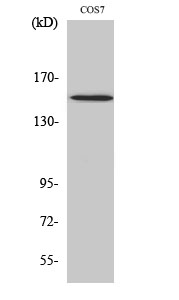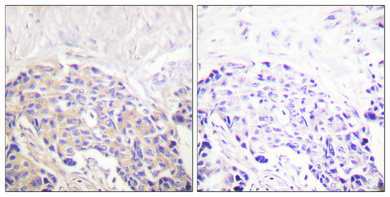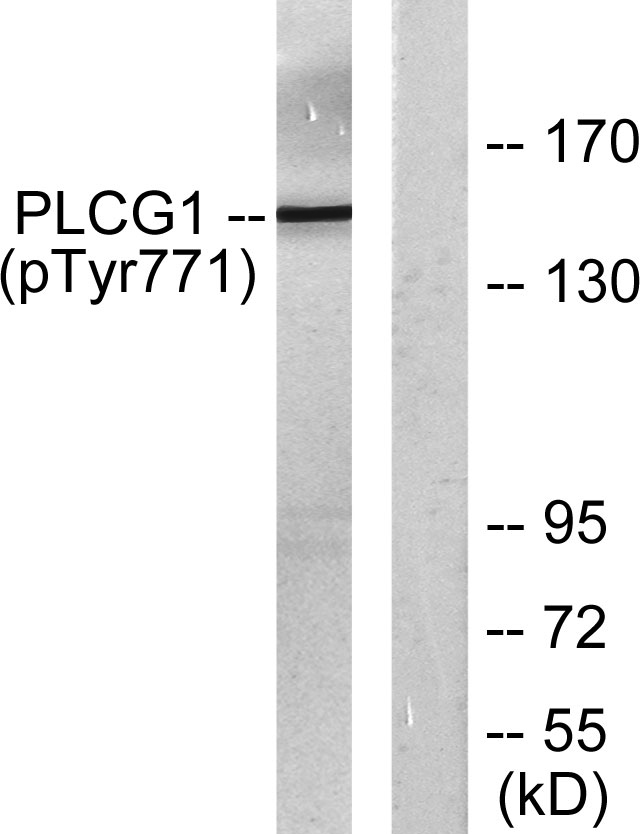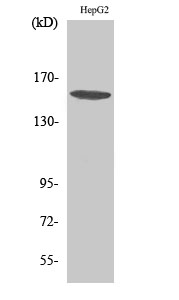PLC γ1 (phospho Tyr771) Polyclonal Antibody
- Catalog No.:YP0607
- Applications:WB;IHC;IF;ELISA
- Reactivity:Human;Mouse;Rat;Monkey
- Target:
- PLCG1
- Fields:
- >>Inositol phosphate metabolism;>>Metabolic pathways;>>EGFR tyrosine kinase inhibitor resistance;>>ErbB signaling pathway;>>Ras signaling pathway;>>Rap1 signaling pathway;>>Calcium signaling pathway;>>Chemokine signaling pathway;>>NF-kappa B signaling pathway;>>HIF-1 signaling pathway;>>Phosphatidylinositol signaling system;>>Phospholipase D signaling pathway;>>Axon guidance;>>VEGF signaling pathway;>>Neutrophil extracellular trap formation;>>Natural killer cell mediated cytotoxicity;>>Th1 and Th2 cell differentiation;>>Th17 cell differentiation;>>T cell receptor signaling pathway;>>Fc epsilon RI signaling pathway;>>Fc gamma R-mediated phagocytosis;>>Leukocyte transendothelial migration;>>Neurotrophin signaling pathway;>>Inflammatory mediator regulation of TRP channels;>>Thyroid hormone signaling pathway;>>AGE-RAGE signaling pathway in diabetic complications;>>Growth hormone synthesis, secretion and action;>>Parkinson disease;>>Pathways of neurodegeneration - multiple diseases;>>Vibrio
- Gene Name:
- PLCG1
- Protein Name:
- 1-phosphatidylinositol 4,5-bisphosphate phosphodiesterase gamma-1
- Human Gene Id:
- 5335
- Human Swiss Prot No:
- P19174
- Mouse Gene Id:
- 18803
- Mouse Swiss Prot No:
- Q62077
- Rat Gene Id:
- 25738
- Rat Swiss Prot No:
- P10686
- Immunogen:
- The antiserum was produced against synthesized peptide derived from human PLCG1 around the phosphorylation site of Tyr771. AA range:736-785
- Specificity:
- Phospho-PLC γ1 (Y771) Polyclonal Antibody detects endogenous levels of PLC γ1 protein only when phosphorylated at Y771.
- Formulation:
- Liquid in PBS containing 50% glycerol, 0.5% BSA and 0.02% sodium azide.
- Source:
- Polyclonal, Rabbit,IgG
- Dilution:
- WB 1:500 - 1:2000. IHC 1:100 - 1:300. ELISA: 1:40000.. IF 1:50-200
- Purification:
- The antibody was affinity-purified from rabbit antiserum by affinity-chromatography using epitope-specific immunogen.
- Concentration:
- 1 mg/ml
- Storage Stability:
- -15°C to -25°C/1 year(Do not lower than -25°C)
- Other Name:
- PLCG1;PLC1;1-phosphatidylinositol 4;5-bisphosphate phosphodiesterase gamma-1;PLC-148;Phosphoinositide phospholipase C-gamma-1;Phospholipase C-II;PLC-II;Phospholipase C-gamma-1;PLC-gamma-1
- Observed Band(KD):
- 150kD
- Background:
- The protein encoded by this gene catalyzes the formation of inositol 1,4,5-trisphosphate and diacylglycerol from phosphatidylinositol 4,5-bisphosphate. This reaction uses calcium as a cofactor and plays an important role in the intracellular transduction of receptor-mediated tyrosine kinase activators. For example, when activated by SRC, the encoded protein causes the Ras guanine nucleotide exchange factor RasGRP1 to translocate to the Golgi, where it activates Ras. Also, this protein has been shown to be a major substrate for heparin-binding growth factor 1 (acidic fibroblast growth factor)-activated tyrosine kinase. Two transcript variants encoding different isoforms have been found for this gene. [provided by RefSeq, Jul 2008],
- Function:
- catalytic activity:1-phosphatidyl-1D-myo-inositol 4,5-bisphosphate + H(2)O = 1D-myo-inositol 1,4,5-trisphosphate + diacylglycerol.,cofactor:Calcium.,domain:The SH3 domain mediates interaction with CLNK (By similarity). The SH3 domain also mediates interaction with RALGPS1.,function:PLC-gamma is a major substrate for heparin-binding growth factor 1 (acidic fibroblast growth factor)-activated tyrosine kinase.,PTM:The receptor-mediated activation of PLC-gamma-1 and PLC-gamma-2 involves their phosphorylation by tyrosine kinases in response to ligation of a variety of growth factor receptors and immune system receptors.,PTM:Ubiquitinated by CBLB in activated T-cells.,similarity:Contains 1 C2 domain.,similarity:Contains 1 EF-hand domain.,similarity:Contains 1 PH domain.,similarity:Contains 1 PI-PLC X-box domain.,similarity:Contains 1 PI-PLC Y-box domain.,similarity:Contains 1 SH3 domain.,simil
- Subcellular Location:
- Cell projection, lamellipodium . Cell projection, ruffle . Rapidly redistributed to ruffles and lamellipodia structures in response to epidermal growth factor (EGF) treatment. .
- Expression:
- Brain,Epithelium,Testis,Vein,
Inhibitory activity of narirutin on RBL-2H3 cells degranulation. IMMUNOPHARMACOLOGY AND IMMUNOTOXICOLOGY Immunopharm Immunot. 2021;43(1):68-76 WB Human RBL-2H3 cells
- June 19-2018
- WESTERN IMMUNOBLOTTING PROTOCOL
- June 19-2018
- IMMUNOHISTOCHEMISTRY-PARAFFIN PROTOCOL
- June 19-2018
- IMMUNOFLUORESCENCE PROTOCOL
- September 08-2020
- FLOW-CYTOMEYRT-PROTOCOL
- May 20-2022
- Cell-Based ELISA│解您多样本WB检测之困扰
- July 13-2018
- CELL-BASED-ELISA-PROTOCOL-FOR-ACETYL-PROTEIN
- July 13-2018
- CELL-BASED-ELISA-PROTOCOL-FOR-PHOSPHO-PROTEIN
- July 13-2018
- Antibody-FAQs
- Products Images

- Western Blot analysis of various cells using Phospho-PLC γ1 (Y771) Polyclonal Antibody

- Immunohistochemical analysis of paraffin-embedded Human breast cancer. Antibody was diluted at 1:100(4° overnight). High-pressure and temperature Tris-EDTA,pH8.0 was used for antigen retrieval. Negetive contrl (right) obtaned from antibody was pre-absorbed by immunogen peptide.

- Immunohistochemistry analysis of paraffin-embedded human breast carcinoma, using PLCG1 (Phospho-Tyr771) Antibody. The picture on the right is blocked with the phospho peptide.

- Western blot analysis of lysates from COS7 cells treated with EGF 200ng/ml 30', using PLCG1 (Phospho-Tyr771) Antibody. The lane on the right is blocked with the phospho peptide.

